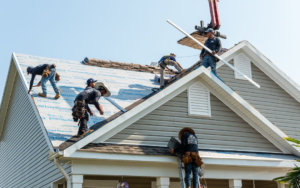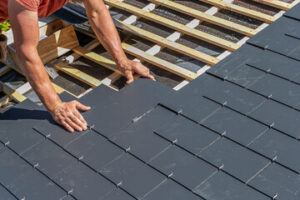Roofing is the dynamic process that creates and maintains your building’s envelope. It includes underlayment, flashing, and shingles that shield buildings from weather conditions, improve energy efficiency, and enhance aesthetics.
The variety of roof shapes and materials is immense, from thatching straw, reeds, or heather to the modern metal panels that grace many homes. Even so, some basic principles apply to all roofs. Contact Roofing Companies Columbus GA now!

There are many different roofing materials available, each offering unique benefits. Choosing the right one for your home is dependent on multiple factors, including cost and maintenance. It’s important to balance these factors with the aesthetics and durability of the roofing material.
Asphalt shingles are a popular choice for homeowners because they’re relatively inexpensive and offer good durability. They’re often found on flat roofs and can withstand heavy roof traffic. Asphalt shingles are also easy to maintain, requiring only regular cleaning and inspections by an experienced roofing professional.
A clay tile roof is another great option for those looking to add texture and style to their homes. These roofs are commonly seen on Spanish-style homes and can withstand a variety of weather conditions. They are also very durable and last for up to 50 years. Concrete tiles are similar to clay tiles but offer a more cost-effective alternative.
Wood shingle and shake roofs are also very attractive. They offer a natural look that ages to a distinctive weathered appearance and can last for up to 30 years in moderate climate zones. However, they’re expensive, high-maintenance, and a poor choice for areas where wildfires are common.
Corrugated metal roofing sheets are very durable and a great choice for commercial and industrial buildings. They’re highly resilient to severe weather and come in a variety of colors and profiles. They’re also available in translucent and transparent options that allow natural sunlight to pass through.
Another roofing material that’s gaining popularity is EPDM roofing membranes. This type of roofing is extremely versatile and can be installed on a variety of roof types, including low-sloped roofs. It’s also water resistant and can hold up against hail damage.
Bitumen roof membranes are another great option for those looking for a low-cost, long-lasting roofing solution. These roofs are typically found on flat or low-pitched roofs and are able to withstand heavy foot traffic. They’re also very waterproof and have a lifespan of 20 to 25 years.
Roof Shapes and Styles
When designing your dream home or choosing a roof for your existing dwelling, it’s important to understand the different types of house roof designs that are available. These roof shapes and styles offer a variety of benefits that can help preserve the integrity and appearance of your home for years to come.
The most common roof design is a gable, which features two triangular sides that converge to the top. This roof shape is ideal for areas with harsh weather conditions, as it allows snow, rain and other elements to slide off easily, reducing the risk of water damage or mold growth. Additionally, this type of roof offers ample space for attic storage or lofts.
Another popular roof design is a hip roof, which features four sloping sides that meet at the ridge or hip. This roof type is renowned for its clean lines and symmetry, making it a popular choice for homes and buildings with many different architectural styles. Hip roofs are also extremely stable, minimizing the risk of structural damage from high winds or heavy rainfall.
A more unique roof design is the saltbox roof, which features a distinctive asymmetrical design. This type of roof is often found on Colonial or Cape Cod-style houses, and it’s characterized by a steeper lower slope and a more gentle upper slope. This roof design is incredibly durable and energy efficient, as it allows for abundant natural light while keeping the home warm in colder weather.
Gambrel roofs are another type of distinctive roof design that’s commonly seen on barns, farmhouses and other rural structures. This type of roof features a steeper lower slope and a gentler upper slope, making it ideal for areas with heavy rainfall or snowfall. They also allow for plenty of space for attic storage or living spaces, as well as a wide range of dormer windows.
A dome roof is another type of uncommon roof design that’s becoming increasingly popular for both residential and commercial buildings. This type of roof features a circular design with a flat surface that’s typically made from asphalt shingles, metal or other materials. Its low profile makes it easy to walk on, and its curved shape offers increased stability while reducing the amount of material needed for the structure.
Roof Installation
Whether built from natural materials like thatch or clay, or made of asphalt shingles, metal panels, or some other material, your roof is a vital shield against the elements. As such, it is an integral part of the overall construction and design of your home. Moreover, roofs are constantly evolving to suit different building styles and climate conditions, as well as personal aesthetic preferences.
To ensure your home is properly protected, you should always work with a professional roofing contractor. During an initial assessment, they can help you choose the best roofing materials that will match your style and budget. They will also identify any underlying issues that may need to be addressed before moving forward with the project. In addition, they can recommend ventilation systems to support healthy airflow and energy efficiency.
Once you’ve chosen a roofing contractor, they will set up protective measures to keep your property safe during the installation process. This includes covering sensitive areas with tarps and placing wooden boards over things like your garden or pool. They will also have a dumpster delivered and cover any open drains to prevent debris from clogging them. In addition, your roofing contractors should communicate clearly with you about daily schedules and potential hazards.
Then, your roofing team will tear off the old roof and begin installing the new one. This phase typically begins at the eaves and works towards the peak. As the shingles or other material are placed, they are carefully cut and nailed down to prevent water leaks. Finally, flashing is installed around areas where the roof meets different surfaces, such as the chimney or vents.
When the job is complete, your contractor will have a final inspection with your local city inspector to ensure it is up to code and meets quality standards. Once approved, you’ll receive a warranty that covers workmanship and material defects for a specified period of time. This will give you peace of mind and protect your investment.
Roof Repair
Whether your roof is in need of minor repairs or a total replacement, you’ll want to understand what’s involved. That way, when you’re ready to find a contractor for the job, you can choose one that has your best interests at heart.
First, the roofers will clear the work area of debris and clean the damaged sections. This not only makes the repair process safer and cleaner for everyone involved, it prevents the spread of any further damage. Next, the roofers will remove any shingles or tiles that are beyond salvageable and replace any underlayment that is deteriorated or water-logged. They’ll also inspect and repair flashing around critical areas like chimneys and vents. Finally, the roofers will install the new shingles or tiles, and re-caulk any seams to ensure the work is watertight and airtight.
What Are the Benefits of a Roof Repair?
There are several types of roofing repairs, each offering different benefits and addressing different issues. The simplest, and most cost-effective, is patching, which involves replacing just a small section of a shingle tile or shingle roof. This option is ideal for fixing minor leaks, repairing cracks, or replacing a single missing shingle.
Another option is re-roofing, which involves covering the existing shingles with a shingle overlay or roofing material. This can help with visual appeal, but doesn’t address underlying damage to the roof deck and only offers a temporary barrier to leaks.
If you’re not sure what type of repair is right for your roof, consult with a professional roofer to conduct an inspection and recommend the appropriate solution. They should be able to provide you with an estimate of the costs and time frame for the project, as well as explain the benefits of each option. They’ll also be able to guide you through the insurance claim process, if applicable. They should have experience working with all types of roofing materials, including shingles, tiles, clay, slate, and more. They should also be familiar with a variety of roof shapes and styles, from basic gable to steep-pitched designs, and custom elements such as dormers and skylights.
